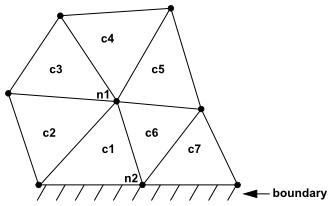For the following discussion, “surface” refers to a collection of facets, lines or points that are created and manipulated in the Setting Up Domain ribbon tab. In most cases, these surfaces are created by computing intersections of constant isovalues with the domain cells or with existing surfaces.
For additional information, see the following sections:
Ansys Fluent stores most variables in cells. For postprocessing, the entire region contained within the cell has this value. A
surface cell value is the value of the cell that has been intersected by a surface facet or line, or that contains a surface point.
Since surface facets and lines are created from the intersection of isovalues and the existing mesh cells, this is a unique
definition. Typically, the cell value on a boundary is the value in the cell adjacent to the boundary. For face-only functions like
Wall Shear Stress, the cell value is the area-weighted average from the face values that define that cell as
c0. This value is used for the cell values of postprocessing surfaces. But for boundary faces, the cell
value actually displays/uses the exact face value.
Node values are explicitly defined or obtained by weighted averaging of the cell data. Various boundary conditions impose values of field variables at the domain boundaries, so mesh node values on these boundary zones are obtained by simple averaging of the adjacent boundary face data. In addition, for several variables (for example, node coordinates or node displacements for the structural model) explicit node values are available at all nodes.
Computation of node values is performed in two steps:
Values at all nodes are initialized to the weighted average of the surrounding cell values. The weights are the inverses of the cell volumes that neighbor the nodes.
At boundaries, these node values are overwritten with the simple average of the boundary face values. Variables for which explicit node values are available at boundaries are indicated by bnv in Table 42.2: Pressure and Density Categories – Table 42.21: Acoustics Category .
For example, in Figure 42.1: Computing Node Values, the value at node will be computed from the weighted average of the values in the surrounding cells (
—
). The value at node
will be computed from the simple average of the boundary faces (
and
) if there are explicit boundary values available for the variable in question.
The values of the nodes on surfaces are linearly interpolated from the mesh node data. For zone surfaces, the nodes on the surface and the zone correspond; therefore, the values are identical. For surfaces that are not zone surfaces (for example, isosurfaces, plane surfaces, and so on), the node values are interpolated from mesh nodes on the cell faces intersected by the postprocessing surface. For point surfaces and structural point surfaces, the value is interpolated from all the mesh nodes of the cell containing the point.
Facets can be created on preprocessing surfaces and postprocessing surfaces.
The interior facets on a zone surface are associated with two cells (c0 and
c1). The values of a specified variable on such facets are computed as the arithmetic average of the two
cell values of the selected variable.
The boundary facet values of a primary field variables on a zone surface are taken from the specified boundary conditions. The boundary values of dependent variables are computed from the adjacent cell values (versus using the value of the primary variable specified at the boundary). For exact values of dependent variables at the boundaries, define a custom field function specifying the boundary conditions as the primary variables. For more information on custom field functions, see Custom Field Functions.
Each facet on a postprocessing surface is associated with a cell. The values of a specified variable on facets are the same as the cell values of the selected variable in the associated cells (this includes iso surfaces, planes, lines, points, rakes, quadric, and so on).



